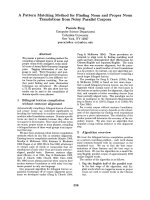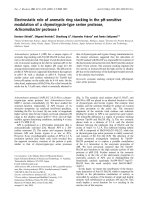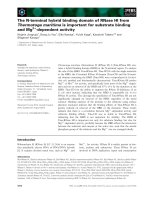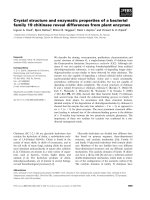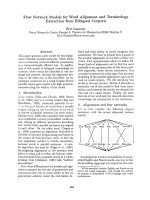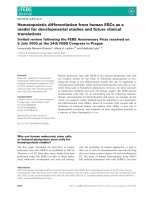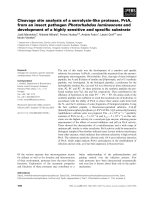ph sensitive films from plant extracts for smart packaging and electrochemical printing
Bạn đang xem bản rút gọn của tài liệu. Xem và tải ngay bản đầy đủ của tài liệu tại đây (9 MB, 132 trang )
<span class="text_page_counter">Trang 1</span><div class="page_container" data-page="1">
MINISTRY OF EDUCATION AND TRAINING
<b>HO CHI MINH CITY UNIVERSITY OF TECHNOLOGY AND EDUCATION FACULTY FOR HIGH QUALITY TRAINING </b>
<b>LECTURER: NGUYEN VINH TIEN</b>
<b>STUDENT: PHAN DANG HONG NHON NGUYEN THI ANH THU</b>
<small>S K L 0 1 2 5 3 1 </small>
</div><span class="text_page_counter">Trang 2</span><div class="page_container" data-page="2"><b>HCMC UNIVERSITY OF TECHNOLOGY AND EDUCATIONFACYLTY OF CHEMICAL AND FOOD TECHNOLOGY</b>
<b>FOOD TECHONOLOGY</b>
<b>GRADUATION THESIS </b>
THESIS CODE: 2023-19116044
<b>HO CHI MINH CITY – January 18, 2024 </b>
<b>pH- SENSITIVE FILMS FROM PLANT EXTRACTS FOR SMART PACKAGING AND </b>
<b>ELECTROCHEMICAL PRINTING</b>
<b>Supervisor:</b>
NGUYEN VINH TIEN, ASSOC.PROF<b>Student conducting:</b>
<b> PHAN DANG HONG NHON 19116044 </b>NGUYEN THI ANH THU 19116029
</div><span class="text_page_counter">Trang 3</span><div class="page_container" data-page="3">i
<b>GRADUATION THESIS ASSIGNMENT </b>
</div><span class="text_page_counter">Trang 4</span><div class="page_container" data-page="4">ii
<b>ACKNOWLEDGEMENT </b>
First of all, we would like to sincerely thank the instructors at the Food Technology Industry High-Quality Training Faculty at Ho Chi Minh City University of Technology and Education for their four years of dedicated instruction and knowledge imparting. They have also set up all the necessary facilities and equipment to help us complete the thesis in the best way possible.
We especially acknowledge the teacher who guided this graduation project, PhD. Nguyen Vinh Tien. He gave us meticulous direction and conveyed the skills and information needed to handle the instruments and run the lab equipment throughout the project. He consistently offered us guidance and encouragement when we encountered problems while working on the project.
We deeply appreciate Ms. Ho Thi Thu Trang of the Department of Food Technology for allowing and supporting us in our use of the instruments and equipment for measurement that are available in the Faculty of Chemical and Food Technology laboratory.
We have tried to learn and research to best complete the graduation thesis. However, there are still many limitations in knowledge and expertise, so shortcomings are inevitable. We look forward to receiving the contributions of teachers and friends to improve the thesis.
We sincerely thank.
</div><span class="text_page_counter">Trang 5</span><div class="page_container" data-page="5">iii
<b>DECLARATION </b>
We hereby declare that all content presented in the graduation thesis is our own work. e hereby certify that the contents referenced in the graduation thesis have been cited accurately and completely in accordance with regulations.
January 18, 2024 (Sign with full name)
</div><span class="text_page_counter">Trang 6</span><div class="page_container" data-page="6">iv
<b>ASSESSEMENT FORM GRADUATION THESIS OF FOOD TECHNOLOGY (SUPERVIOR) </b>
</div><span class="text_page_counter">Trang 7</span><div class="page_container" data-page="7">v
</div><span class="text_page_counter">Trang 8</span><div class="page_container" data-page="8">vi
<b>ASSESSEMENT FORM GRADUATION THESIS OF FOOD TECHNOLOGY (REVIEWER) </b>
</div><span class="text_page_counter">Trang 9</span><div class="page_container" data-page="9">vii
</div><span class="text_page_counter">Trang 10</span><div class="page_container" data-page="10">viii
<b>ASSESSEMENT FORM GRADUATION THESIS OF FOOD TECHNOLOGY (COMMITTEE </b>
<b>MEMBER) </b>
</div><span class="text_page_counter">Trang 11</span><div class="page_container" data-page="11">ix
</div><span class="text_page_counter">Trang 12</span><div class="page_container" data-page="12">x
</div><span class="text_page_counter">Trang 13</span><div class="page_container" data-page="13">xi
</div><span class="text_page_counter">Trang 14</span><div class="page_container" data-page="14">xii
</div><span class="text_page_counter">Trang 15</span><div class="page_container" data-page="15">xiii
</div><span class="text_page_counter">Trang 16</span><div class="page_container" data-page="16"><b>TABLE OF CONTENT ... xiv</b>
<b>LIST OF FIGURES ... xviii</b>
<b>LIST OF TABLES ... xxii</b>
<b>LIST OF ABBREVIATION ... xxiii</b>
<b>CHAPTER 1. INTRODUCTION ... 1</b>
1.1. The urgency of the project ... 1
1.2. Objectives of the project ... 2
1.3. Object and scope of the project ... 2
1.4. Content of the project ... 3
1.5. Scientific and practical significance... 3
<b>CHAPTER 2. OVERVIEW ... 4</b>
2.1. Overview of pH indicator packaging ... 4
2.2. Biodegradable packaging materials – pH indicator ... 5
2.2.1. Polyvinyl alcohol (PVA) ... 5
2.2.1.1. Overview of Polyvinyl alcohol (PVA)... 5
</div><span class="text_page_counter">Trang 17</span><div class="page_container" data-page="17">2.2.5.4. Factors affecting anthocyanin stability ... 15
Overview of Turmeric powder ... 18
Characteristic of turmeric powder ... 19
2.2.6. Curcumin ... 20
2.2.6.1. Overview of curcumin ... 20
2.2.6.2. Chemical structure ... 21
2.2.6.3. Characteristic of curcumin ... 21
2.2.6.4. Factors affecting curcumin stability ... 23
<b>CHAPTER 3: MATERIALS AND RESEARCH METHODS ... 26</b>
3.1. Materials ... 26
3.2. Diagram of the research process ... 27
</div><span class="text_page_counter">Trang 18</span><div class="page_container" data-page="18">3.3.2. Extracting curcumin from turmeric powder ... 33
3.3.3. Determine the absorption spectrum and color-changing potential according to the pH of the extracts of butterfly flowers, red cabbage, and turmeric .. 34
3.3.3.1. Determine the absorption spectrum and color-changing potential according to the pH of the extracts of butterfly pea flower and read cabbage ... 34
3.3.3.2. Determine the absorption spectrum and color-changing potential according to the pH of the extracts of turmeric ... 34
3.3.3.3. Determine the absorption spectrum and ability to change color according to pH of a mixture of butterfly pea flower and turmeric extract or red cabbage and turmeric extract. ... 37
3.3.4. Film formation with a single extract ... 37
3.3.5. Film formation with a double extract ... 38
3.3.6. The pH affects the color and appearance of the film ... 39
</div><span class="text_page_counter">Trang 19</span><div class="page_container" data-page="19">xvii
<b>CHAPTER 4. RESULTS AND DISCUSSION ... 48</b>
4.1 Effect of pH and absorption spectrum of anthocyanin ... 48
4.1.1 Butterfly pea flower ... 49
4.1.2. Red cabbage ... 52
4.2. Effect of pH and absorption spectrum of curcumin ... 54
4.3. Effect of pH and absorption spectrum of curcumin and anthocyanin ... 59
4.3.2. Effect of pH and absorption spectrum of TB 1:1 ... 59
4.3.3. Effect of pH and absorption spectrum of TB 1:14 ... 61
4.3.4. Effect of pH and absorption spectrum of TR 1:1 ... 64
4.3.5. Effect of pH and absorption spectrum of TR 1:14 ... 67
4.5.1 Fourier Transform Infrared Spectroscopy (FTIR) ... 83
4.6. Application of films in monitoring the spoilage of yellowtail catfish, chicken and shrimp ... 85
4.7. Electrochemical writing ... 89
<b>CHAPTER 5. CONCLUSION ... 91</b>
<b>REFERENCES ... 93</b>
<b>APPENDIX ... 105</b>
</div><span class="text_page_counter">Trang 20</span><div class="page_container" data-page="20">xviii
<b>LIST OF FIGURES </b>
Figure 2. 1 Structural formula for Polyvinyl alcohol: partially hydrolyzed (left); fully
hydrolyzed (right) ... 6
Figure 2. 2 Butterfly pea flower ... 10
Figure 2. 3 Red cabbage ... 11
Figure 2. 4 Color changes of red cabbage extract at different pH values ... 13
Figure 2. 5 Chemical structure of anthocyanins ... 14
Figure 2. 6 Structural classification of 6 most common anthocyanidins ... 15
Figure 2. 7 Main anthocyanins structures and pH dependent speciation equilibria suggested in this work for anthocyanin species ... 16
Figure 2. 8 Chemical structure of curcumin ... 21
Figure 2. 9 Chemical structure of curcumin with two forms keto (left) and enol (right). ... 21
Figure 2. 10 Color change of curcumin from pH 5-11 (left to right) ... 22
Figure 2. 11 Degradation of curcumin is an autoxidation to a bicyclopentadione. ... 23
Figure 3. 1 Diagram of experimental research ... 27
Figure 3. 2 Diagram of extracting extract from butterfly pea flowers (left) and red cabbage (right) used to create films ... 28
Figure 3. 3 Diagram of extracting extract from turmeric powder used to create films ... 29
Figure 3. 4 Flow chart of film creation process from single extracts such as red cabbage, butterfly pea flower, and turmeric ... 30
Figure 3. 5 Flow chart of film creation process from double extracts such as red cabbage with turmeric extract or butterfly pea flower with turmeric extract ... 31
Figure 3. 6 Mechanical equipment ... 44
Figure 3. 7 Electrochemical drawing process diagram ... 45
Figure 3. 8 Electrochemical drawing process diagram ... 46
Figure 3. 9 Monitoring the freshness of chicken meat using a pH indicator film ... 47
</div><span class="text_page_counter">Trang 21</span><div class="page_container" data-page="21">xix
Figure 4. 1 Structure of anthocyanin at varying pH (Ghaani et al., 2016) ... 49
Figure 4. 2 Colors of butterfly pea flower extracts at pH 1-12 ... 49
Figure 4. 3 The spectrum of the butterfly pea flower extract from pH 1-12 ... 50
Figure 4. 4 The spectrum of the butterfly pea flower extract from pH 1-2 ... 50
Figure 4. 5 The spectrum of the butterfly pea flower extract from pH 3-6 ... 51
Figure 4. 6 The spectrum of the butterfly pea flower extract from pH 7-12 ... 51
Figure 4. 7 Color of red cabbage extract at pH 1-12 ... 52
Figure 4. 8 The spectrum of the red cabbage extract from pH 1-12 ... 52
Figure 4. 9 The spectrum of the red cabbage extract from pH 1-3 ... 53
Figure 4. 10 The spectrum of the red cabbage extract from pH 4-6 ... 53
Figure 4. 11 The spectrum of the red cabbage extract from pH 7-12 ... 54
Figure 4. 12 Colors of turmeric extracts at pH 1-12 ... 55
Figure 4. 13 The spectrum of the turmeric extract from pH 1-12... 55
Figure 4. 14 The spectrum of the turmeric extract from pH 1-7... 56
Figure 4. 15 The spectrum of the turmeric extract from pH 7-12... 56
Figure 4. 16 Structure of curcumin (A) and color change of the extract at different pH values. (Esatbeyoglu et al., 2012) ... 57
Figure 4. 17 Conversion of curcumin in aqueous media under different conditions. (Bhatia et al., 2016) ... 58
Figure 4. 18 Colors of turmeric- butterfly pea flower (1:1) extracts at pH 1-12 ... 59
Figure 4. 19 The spectrum of the turmeric-butterfly pea flower extract (1:1) from pH 1-12 ... 59Figure 4. 20 The spectrum of the turmeric-butterfly pea flower extract (1:1) from pH 1-2 60Figure 4. 21 The spectrum of the turmeric-butterfly pea flower extract (1:1) from pH 3-6 60
</div><span class="text_page_counter">Trang 22</span><div class="page_container" data-page="22">xx
Figure 4. 22 The spectrum of the turmeric-butterfly pea flower extract (1:1) from pH 7-12 ... 61Figure 4. 23 Colors of turmeric - butterfly pea flower extracts (1:14) at pH 1-12 ... 61Figure 4. 24 The spectrum of the turmeric-butterfly pea flower extract (1:14) from pH 1-12 ... 62Figure 4. 25 The spectrum of the turmeric-butterfly pea flower extract (1:14) from pH 1-2 ... 62Figure 4. 26 The spectrum of the turmeric-butterfly pea flower extract (1:14) from pH 3-6 ... 63Figure 4. 27 The spectrum of the turmeric-butterfly pea flower extract (1:14) from pH 7-12 ... 63Figure 4. 28 Colors of turmeric - red cabbage extracts (1:1) at pH 1-12 ... 64Figure 4. 29 The spectrum of the turmeric-red cabbage extract (1:1) from pH 1-12 ... 65Figure 4. 30 The spectrum of the turmeric-red cabbage extract (1:1) from pH 1-2 ... 65Figure 4. 31 The spectrum of the turmeric-red cabbage extract (1:1) from pH 4-6 ... 66Figure 4. 32 The spectrum of the turmeric-red cabbage extract (1:1) from pH 7-12 ... 66Figure 4. 33 Colors of turmeric - red cabbage extracts (1:14) at pH 1-12 ... 67Figure 4. 34 The spectrum of the turmeric-red cabbage extract (1:14) from pH 1-12 ... 67Figure 4. 35 The spectrum of the turmeric-red cabbage extract (1:14) from pH 1-3 ... 68Figure 4. 36 The spectrum of the turmeric-red cabbage extract (1:14) from pH 4-6 ... 68Figure 4. 37 The spectrum of the turmeric-red cabbage extract (1:14) from pH 7-12 ... 69Figure 4. 38 Original appearance of film ... 70Figure 4. 39 Moisture content of film samples containing single and double extracts ... 77Figure 4. 40 The water vapor permeability of film samples containing single and double extracts ... 78Figure 4. 41 Tensile strength of film samples containing single and double extracts ... 79
</div><span class="text_page_counter">Trang 23</span><div class="page_container" data-page="23">xxi
Figure 4. 42 Elongation at break of film samples containing single and double extracts ... 80Figure 4. 43 Optical transmittance of all membrane samples ... 81Figure 4. 44 FTIR spectrogram of the films ... 83Figure 4. 45 FTIR spectrogram of the film from wavelength 1800-800 ... 83Figure 4. 46 Monitoring the freshness of chicken using a pH indicator film at 0h ... 86Figure 4. 47 Monitoring the freshness of fish using a pH indicator film at 0h... 86Figure 4. 48 Monitoring the freshness of shrimp using a pH indicator film at 0h ... 86Figure 4. 49 Ability to display colors when electrochemically printing films samples ... 89
</div><span class="text_page_counter">Trang 25</span><div class="page_container" data-page="25">xxiii
<b>LIST OF ABBREVIATION </b>
PVA: Polyvinyl alcohol CGN: Carrageenan S: Standard
B: Butterfly pea flower T: Turmeric
R: Red cabbage
TB 1:1: Turmeric-Butterfly pea flower (1:1) TB 1:14: Turmeric-Butterfly pea flower (1:14) TR 1:1: Turmeric-Red cabbage (1:1)
TR 1:14: Turmeric-Red cabbage (1:14) ATH: Anthocyanin
</div><span class="text_page_counter">Trang 26</span><div class="page_container" data-page="26">1
<b>CHAPTER 1. INTRODUCTION </b>
<b>1.1. The urgency of the project </b>
Packaging is designed to ensure the product's quality, wholesomeness, integrity, and safety. Food, when correctly packaged, can endure from a few hours to a few days, or even months, depending on its composition and a variety of external circumstances. (Kalpana et al., 2019)
Food packaging is an essential component of the food supply chain because it functions as a protective layer or barrier against contamination, the external environment, and mechanical damage during transit, all of which can have a negative impact on product quality. Aside from the sustainability of food packaging, correct shelf-life information is another key issue that must be addressed. The remaining shelf life of a product cannot be determined only by the use-by date printed on the box, as it can be impacted by a variety of factors such as mistreatment, temperature abuse, and so on.
In order to precisely evaluate product quality in real time, it is interesting to monitor the storage conditions of packed foods using smart food packaging. Because the pH label generates a consistent color reaction to determine the degree of food decomposition during storage, it may be a useful indicator of the freshness of many perishable commodities, including seafood, meat, fish, milk, and fruit.
Indicators that change color reversibly in response to pH variations are commonly employed in pH indicator packages. Common pH indicators are natural substances found in plants, such as anthocyanins and curcumin. Many fruits and vegetables contain anthocyanins, which have the benefits of antioxidant activity and a consistent color response to pH fluctuations. The difference in anthocyanin structure between buffer solutions is what causes the apparent color variation. Anthocyanins with distinct structures and contents, found in a variety of plant sources, display a range of color channels. Red cabbage and butterfly pea flowers are two of the best kinds because they are widely available and high in anthocyanins. Additionally, turmeric is used to extract curcumin, and color changes in turmeric correspond to pH changes. At various pH levels, curcumin undergoes structural modifications that cause consistent and perceptible color shifts. (Zhang, Huang, Yan, Hu, & Ren, 2020)
</div><span class="text_page_counter">Trang 27</span><div class="page_container" data-page="27">2
Item packaging printing can offer crucial details about the item, like the manufacturing date and storage conditions. The majority of food packaging materials have labels on them to convey information about the foods they contain, and since most inks are made from petrochemical feedstock, modern society has serious worries about environmental sustainability. Furthermore, there is a chance that contaminated printing inks will seep from packaging into food.
Their color is caused by the extraction of curcumin from turmeric and anthocyanins from plants in nature. It is widely utilized in the food and beverage industries and is non-toxic. The ability of anthocyanins and curcumins to alter color in response to pH variations over a broad range is one of their distinctive qualities. Recently, patterns based on the pH-responsive color change of anthocyanins and curcumin have been successfully printed on polysaccharide film using the electrochemical writing approach. This electrochemical writing technique can be considered a green printing approach because curcumin and anthocyanins are biodegradable and nontoxic. (Zhai et al., 2018)
Thus, we investigated pH indicator films in this work by mixing two polyvinyl alcohol (PVA) and carrageenan (CGN)-with anthocyanin (found in red cabbage and butterfly pea flowers) and curcumin (found in turmeric powder). Using various extract mixes and mixing ratios to create a film model with the ideal characteristics for use in food. Furthermore, a monitoring method was introduced, and the film was employed to demonstrate the spoilage processes in chicken, shrimp and yellowtail catfish. Electrochemical drawing was also investigated for possible application in food packaging.
<b>polymers-1.2. Objectives of the project </b>
The goal of the experiment was to investigate pH-sensitive films using extracts from red cabbage, turmeric powder, and butterfly pea flowers along with two polymers, polyvinyl alcohol and carrageenan. Assess the film's appearance, pH-indicator color change characteristics, transparency measurement, water vapor permeability, mechanical properties and chemical characteristics, its electrochemical drawing, application of the film on foods and, track the film's color change as the food deteriorates.
<b>1.3. Object and scope of the project </b>
Research object: pH indicator film based on curcumin (found in turmeric powder) and anthocyanin (found in red cabbage and butterfly pea flowers).
</div><span class="text_page_counter">Trang 28</span><div class="page_container" data-page="28">3
Scope of the study: This study was carried out on a laboratory scale
<b>1.4. Content of the project </b>
Survey and analyze the properties of color indicators (extracts from butterfly pea flowers, red cabbage, and turmeric).
Investigate the influence of colorants and extract mixing ratios on the following properties: appearance, ability to change color according to pH, and chemical properties.
Studies on the characteristics of pH indicator films made from extracts of several natural substances, including red cabbage, turmeric powder, and butterfly pea flowers:
<b>1.5. Scientific and practical significance </b>
The specific characteristics, physicochemical properties, and applicability of pH indicator films for use in food have all been determined by the research.
Through this research, it will be possible to increase consumer awareness about using biodegradable packaging to replace plastic packaging. In addition, the use of pH indicator films helps minimize the use of dyes on food packaging, such as electrochemical writing on the surface of pH indicator films instead of using dyes for printing.
</div><span class="text_page_counter">Trang 29</span><div class="page_container" data-page="29">4
<b>CHAPTER 2. OVERVIEW </b>
<b>2.1. Overview of pH indicator packaging </b>
In general, people use the expiration date printed on food packaging to assess the product's quality, freshness, deliciousness, and safety. The expiration date alone, however, is insufficient to assess the quality and freshness of certain commodities, such as fresh fruits, vegetables, meat, seafood, etc. As a result, the employment of pH indicator packaging to detect, measure, monitor, and preserve food quality is regarded as a novel, creative, and clever product.
Intelligent packaging uses colorimetric changes or sensors attached to the package to communicate information about the food quality inside the package. Sensors are electronic devices that identify, capture, and communicate changes in quality and product information that could happen within a package or while it's being transported. Generally, indicators provide details on changes in the good or the surroundings in which it is conditioned in colorimetric systems that monitor temperature, pH, and time.
Apart from serving as a barrier to food safety, intelligent packaging has the ability to instantly release a signal (which may be electrical, colorimetric, or another type) in reaction to any alteration in the initial packaging circumstances or the quality of the food. The two components of a typical pH indicator package are a solid base and a color extract that is sensitive to pH and serves as the colorimetric sensor. Colored extracts are extracted from many fruits and vegetables or synthetically. The pH of some foods changes when the degradation process starts. One measure of the quality of the product is this change. The pH shifts at the beginning of the degradation process, changing the color of the sensor or package. In this way, a food package that provides the pH of the food before it is purchased or consumed is an assurance to the customer of the product's quality and safety. (Balbinot-Alfaro et al., 2019)
According to (Liu et al., 2018), To assess the freshness of shrimp and pork, pH colorimetric indicator films based on curcumin and carrageenan were created. Hydrogen bonds mediated the interactions between curcumin and carrageenan, with the curcumin partly crystalline when incorporated into the carrageenan matrix. A suitable quantity of curcumin (no more than 3%), in addition to increasing thermal stability, may greatly strengthen the film barrier (against oxygen and moisture) and tensile strength. Under alkaline
</div><span class="text_page_counter">Trang 30</span><div class="page_container" data-page="30">5
conditions, carrageenan-curcumin films exhibited a strong redness-shift (i.e., yellow to red). Targeting films may have a lot of potential for monitoring the freshness of meals containing animal protein, as demonstrated by their successful use as a pH colorimetric indicator for shrimp and pork.
For the purpose of nondestructively determining fish freshness in real time, visual pH-sensing films containing curcumin (CR) and anthocyanins (ATH) were created as on-package indicator labels. CR and ATH were successfully adsorbed onto the film-forming substrate based on starch, polyvinyl alcohol (SPVA), and glycerol, according to a Fourier transform infrared spectroscopy study. The thickness of colorimetric films, moisture content, water solubility, and water vapor permeability were all unaffected significantly by the addition of various natural dyes. The pH range of 5 to 11 could be used to study color changes using the natural dye solutions. FTIR spectrum studies indicated that natural dyes might work well with substrates that produce films. The best correlation to the degree of fish freshness (freshness, medium freshness, and spoilage) was shown by the starch/polyvinyl alcohol/glycerol composite film that was mixed with CR and ATH at a ratio of 2:8 (v/v) (SPVAG/ATH/CR). This allowed for real-time monitoring of fish deterioration. An intelligent film containing a combination of CR and ATH might be an excellent indicator material for nondestructively monitoring the freshness of fish items. (Chen, Zhang, Bhandari, & Yang, 2020)
<b>2.2. Biodegradable packaging materials – pH indicator </b>
<b>2.2.1. Polyvinyl alcohol (PVA) </b>
<b>2.2.1.1. Overview of Polyvinyl alcohol (PVA) </b>
Poly (vinyl alcohol) (PVA) is a synthetic polymer that has good biocompatibility, a degree of biodegradability, and hydrophilicity (-OH groups). Due to the unstable nature of vinyl alcohol (which is easily tautomerized into acetaldehyde) as monomeric units, PVA is synthesized in two steps: (a) vinyl acetate polymerization by free radicals in an alcoholic solution; and (b) partial hydrolysis of poly (vinyl acetate) (VAc). Due to its special qualities—such as water solubility, great biocompatibility, low toxicity, film orientation features, and adhesive properties—it is a frequently used polymeric material in processing. (A. Kumar, Han, & biomaterials, 2017)
</div><span class="text_page_counter">Trang 31</span><div class="page_container" data-page="31">It is important to employ PVA to regulate melt temperature, fluidity, and thermal stability, particularly for screw extrusion and injection molding procedures that are frequently used in packaging. By enhancing segment mobility and lowering crystallinity, plasticizers added to PVA can lower melting temperatures and brittleness while enhancing flexibility and processability. Additionally, in packaging applications where minimizing plastic waste is the primary objective, it possesses strong mechanical qualities and exceptional chemical resistance. PVA is made using traditional chemical synthesis techniques from monomers with a sustainable biological origin or from a combination of biomass and petroleum sources. (Abdullah, Dong, Davies, Barbhuiya, & Engineering, 2017)
</div><span class="text_page_counter">Trang 32</span><div class="page_container" data-page="32">7
<b>2.2.1.2. Characteristic of PVA </b>
<b> Water solubility: PVA is soluble in water and hot alcohol but is insoluble in aliphatic </b>
and aromatic hydrocarbons, esters, ketones, and oils (Table 2.1). Residual acetate groups are present in partially hydrolyzed PVA, which is occasionally referred to as a copolymer of vinyl acetate and vinyl alcohol. These groups have the ability to restrict hydrogen bonding with nearby –OH groups, which increases the permeability, water absorption, and solubility of mixtures. (Abdullah et al., 2017).
In comparison to PVA with a high degree of hydrolysis (DH), PVA with a low DH is more soluble in water at low temperatures. The intra- and intermolecular hydrogen bonds of adjacent ‒OH groups are actually weakened by the remaining acetate groups, which are hydrophobic in nature. As a result, PVA with high DH requires temperatures well over 70°C to dissolve in a water environment. After heat treatment, the remaining acetate groups aid in the crystallization of PVA chains. As a result, it is harder for PVA grades with high DH to crystallize. The degree of hydrolysis affects regioselectivity, tacticity, and molecular weight, among other features. (A. Kumar et al., 2017)
<b> Film forming ability: Synthetic polymers like polyvinyl alcohol are extensively </b>
utilized in industries like packaging, film production, polymer recycling, and pharmaceuticals. PVA has strong biocompatibility qualities, is non-carcinogenic, biodegradable, and safe for human health. Besides, it has good film-forming ability, is highly hydrophilic and water-soluble, and has outstanding chemical stability. It is combined with other synthetic and natural polymers to improve its mechanical qualities, pH resistance, biodegradable and film-forming ability. (Tripathi, Mehrotra, & Dutta, 2009)
<b> Biodegradability: One acknowledged possibility for a biodegradable polymeric </b>
material is polyvinyl alcohol. This composite may be completely consumed by microorganisms without releasing harmful pollutants into the environment, making it appropriate for use as a biodegradable packaging material. (Rahman, Sin, Rahmat, & Samad, 2010)
<b>2.2.2. Carrageenan (CGN) </b>
<b>2.2.2.1. Overview of Carrageenan (CGN)</b>
Carrageenan is a natural polysaccharide extracted from edible red seaweeds of Rhodophycea class. Linear sulfated polysaccharides, known as carrageenan, are made up of
</div><span class="text_page_counter">Trang 33</span><div class="page_container" data-page="33"><b>2.2.2.2. Characteristic of CGN </b>
<b>Water solubility: Most types of carrageenan are soluble in hot water (Table 2.2). </b>
Numerous factors, including temperature, the presence of ions, the amount of carrageenan, etc., determine how soluble carrageenan is in water. Different kinds of salts have varying impacts on the gelling and phase transitions of ι-and κ -carrageenan gels. It has been shown that when KCl was present, stronger κ -carrageenan gels were produced in comparison to other salts including NaCl, MgCl<small>2</small>, LiCl, SrCl2, and CaCl<small>2</small>. In the meantime, there was a substantial correlation between the KCl, NaCl, and CaCl<small>2</small> levels and the gel-sol transition temperatures of κ-carrageenan. At all temperatures, λ-carrageenan exhibits a random coil
</div><span class="text_page_counter">Trang 34</span><div class="page_container" data-page="34">9
shape and is incapable of forming gel. λ -carrageenan is able to a viscosity agent. (Zia et al., 2017)
<b>Film forming ability: Solvent casting, which entails casting carrageenan gel and </b>
then evaporating the solvent (water) to form a solid film, is the technique used to fabricate films to date. In the presence of calcium salts, ι-carrageenan usually forms a transparent, elastic, soft gel without syneresis, while κ-carrageenan typically produces a strong, hard, brittle gel. ι-carrageenan's three-dimensional structure reveals a compact, dense, and well-organized film structure. Such films may also have reduced gas permeability in packing applications, which could help prevent surface drying and preserve some items' flavor characteristics. The compact film structure of κ-carrageenan polymers is attributed to their high gelling ability, which also confers outstanding film-forming capabilities with higher mechanical and water barrier properties and increased transparency. (Sedayu, Cran, & Bigger, 2019)
<b>Gel-forming ability: κ- and ι-carrageenan show a thermos reversible sol-gel </b>
transition in an aqueous solution, while λ-carrageenan solutions do not form a gel state. Carrageenan gelation has been explained as a conformational change from random coils to helical structures, which assemble when the temperature drops and/or when cations are present in the solution. The anhydro-galactose sequences in the carrageenan conformation adopt a random coil formation in the sol-phase, twisting into a double helix at low temperatures. The twisted double-helical portions also aggregate further, and together they create a cross-linked domain that forms an infinite network structure that enables gelation.
Moreover, it has been discovered that the cations aid in the gelation process by mediating between the double helices since the repeating units of the ester sulfate groups are electrically charged. The temperature of the solution, the kinds of cations present, and the quantity and molecular weight of the galactan all influence the transition kinetics during this process. The coil-helix transition temperature, or 38°C and 45°C, respectively, is the point at which the molecular configuration of κ- and ι-carrageenan changes from random coils to double helices in an aqueous solution. In κ- or ι-carrageenan solutions, a minimum polymerization degree of around one hundred is needed to produce a helical structure. The conformational transition of the polymer during gel formation from the random coil state to the helical state and the functional properties of the polymer are determined by the structure
</div><span class="text_page_counter">Trang 35</span><div class="page_container" data-page="35">pelargonidin is responsible for the orange-red color, cyanidin for red hues, and delphinidin for lilac to blue hues. Anthocyanins also have extensive applications as natural supplements and have demonstrated anti-inflammatory, antioxidant, anticarcinogenic, and antimicrobial properties, including anti-candida activities (Ongkowijoyo, Luna-Vital, & de Mejia, 2018; Rupasinghe, Arumuggam,
Figure 2. 2 Butterfly pea flower
<b>2.2.3.2. Characteristic of butterfly flower </b>
Bioactive compounds have been associated with numerous health benefits, including reduced cardiovascular risks and properties that combat cancer and diabetes (Samtiya, Aluko, Dhewa, & Moreno-Rojas, 2021). One significant category of bioactive compounds is phenolics, which, when consumed, offer various health advantages due to their antioxidant
</div><span class="text_page_counter">Trang 36</span><div class="page_container" data-page="36">11
and anti-inflammatory properties (N. Kumar & Goel, 2019). Butterfly pea flowers are recognized as a rich source of phenolic compounds, with a content of approximately 30 mg gallic acid equivalents per gram of dry matter (Vuong & Hongsprabhas, 2021). They are commonly considered a medicinal plant in many Asian countries (Lakshan, Jayanath, Abeysekera, & Abeysekera, 2019; Mukherjee, Kumar, Kumar, & Heinrich, 2008; Vidana Gamage, Lim, & Choo, 2021). The primary phenolic compounds found in butterfly pea flowers include ternatin, kaempferol, quercetin, and myricetin (Vidana Gamage et al., 2021). Extracts from butterfly pea flowers have demonstrated anti-allergic and anti-arthritic activities, underscoring their therapeutic potential (Adhikary, Sultana, & Bishayi, 2018). With a high anthocyanin content of approximately 9 mg ternatin B2 equivalents per gram of dry matter (Vuong & Hongsprabhas, 2021), butterfly pea flowers offer various opportunities for use as a natural blue food coloring agent in a range of food products (Fu et al., 2021). In addition to bioactive components, edible flowers can also serve as a source of dietary fiber. Studies have shown that the total dietary fiber content in edible flowers can reach up to 62 grams per 100 grams of flower (on a dry basis) (Jakubczyk, Koprowska, Gottschling, & Janda-Milczarek, 2022).
<b>2.2.4. Red cabbage </b>
<b>2.2.4.1. Overarching introduction </b>
Brassicaceae vegetables are an essential element of the global human diet, are enjoyed by people all over the world, and are key food crops in China, Japan, India, and Europe (Cartea et al., 2010). It not only serves as an antioxidant, but it also possesses various health-promoting properties due to its bioactive ingredients (Patras et al., 2011). The
Figure 2. 3 Red cabbage
</div><span class="text_page_counter">Trang 37</span><div class="page_container" data-page="37">12
Brassicaceae family includes red cabbage. It is a cruciferous vegetable that grows in the cool season. Red cabbage (Brassica oleracea var. capitata f. rubra) is a variety of cabbage that is widely produced in the Mediterranean region (Lynn et al., 2006), but it is also grown in other regions of the world. Red cabbage is a blooming plant that is herbaceous, biennial, and dicotyledonous. It features a short stem with a crown of red-colored leaves on top. Red cabbage gets its name because its leaves are purple or crimson due to a substance called anthocyanin. The color varies depending on the PH of the soil. Acidic soil produces crimson leaves, neutral soil produces purple leaves, while alkaline soil produces greenish yellow cabbage. The ideal temperature for growth is between 15 and 18 degrees Celsius. It is less heat tolerant but can withstand freezing temperatures (Fernandes et al., 2019).
<b>2.2.4.2. Characteristic of red cabbage </b>
Red cabbage is abundant in phenolic compounds known as anthocyanins, which are the primary flavonoids present in this vegetable. Anthocyanins are responsible for providing red cabbage with its potent antioxidant properties, surpassing the antioxidant capacity of over 150 other flavonoids. Red cabbage owes its strong antioxidant capacity primarily to these anthocyanins. The anthocyanin pigments found in red cabbage mainly consist of cyanidin 3-sophoroside-5-glucoside and cyanidin 3-sophoroside-5-glucoside, which are acylated with sinapic acid, ferulic acid, p-coumaric acid, and malonic acid. Additionally, red cabbage contains significant compounds such as isothiocyanates (glucosinolates), polyphenols, glucoraphanin, sinigrin, and glucoiberin. Of these, glucoraphanin can be transformed into sulforaphane, a well-known cancer chemopreventive isothiocyanate. Furthermore, red cabbage is a rich source of various vitamins, including vitamin A, C, K, and B, as well as thiamin, riboflavin, and folate. It also provides essential minerals such as calcium, magnesium, manganese, iron, nickel, and zinc, along with dietary fiber. Additionally, red cabbage contains vitamins E, carotene, and tocopherol (Fernandes et al., 2019)
</div><span class="text_page_counter">Trang 38</span><div class="page_container" data-page="38">Anthocyanins are widely present in many plants' flowers and fruits, contributing to the red, purple, and blue hues of many blooms. Notable red flowers containing anthocyanins include red hibiscus, red rose, red pineapple sage, red clover, and pink blossom, all of which are edible. Similarly, blue and purple flowers like cornflower, blue chicory, blue rosemary, purple mint, purple passion flower, purple sage, common violet, and lavender are also commonly edible and have been used traditionally in folk medicine, as dyes, and as food.
</div><span class="text_page_counter">Trang 39</span><div class="page_container" data-page="39">14
Beyond their aesthetic value, the pigments in red, purple, and blue fruits, such as berries, blackcurrants, and others, serve as powerful antioxidants. Additionally, foods rich in anthocyanin like black carrots, red cabbage, and purple potatoes have been recognized as functional foods, consumed for their health benefits and disease prevention properties (Khoo et al., 2017)
<b>2.2.5.2. Chemical structure </b>
Anthocyanins are polyphenols that belong to the flavonoid group and are responsible for the red and blue colors found in various plant organs such as fruits, flowers, and leaves." Anthocyanin molecules occur naturally in plants as glycosides (gly), where the anthocyanidin is linked to a sugar group. This sugar group is connected to an aglycone and can contain glucose, galactose, rhamnose, xylose, or arabinose. Anthocyanidins are polyhydroxy or polymethoxy derivatives of 2-phenylbenzopyrylium with two benzoyl rings (A and B) separated by a heterocyclic ring (C) Fig 2.5. There are about 17 distinct anthocyanidins found in nature, but only six are regularly found and distributed: cyanidin (cy), delphinidin (dp), petunidin (pt), peonidin (peo), pelargonidin (pl), and malvidin Figure 2 (Pojer et al., 2013)
Figure 2. 5 Chemical structure of anthocyanins (Pojer et al., 2013)
</div><span class="text_page_counter">Trang 40</span><div class="page_container" data-page="40"><b>2.2.5.4. Factors affecting anthocyanin stability </b>
<b>Influence of pH: pH is shown to be the most important factor affecting the colour of </b>
anthocyanin (Mazza & Brouillard, 1987). Anthocyanins have a structural foundation rooted
</div>
